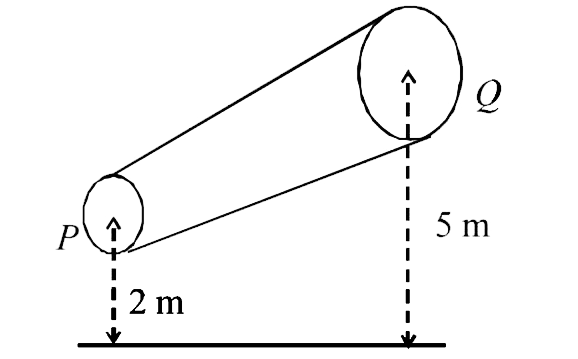The ability to rise in thin tubes and Ability to resist a pulling force are respectively referred to as
Tensile strength and capillarity
Cohesion and adhesion
Capillarity and tensile strength
Adhesion and capillarity
The correct Answer is:C
To answer the question regarding the ability to rise in thin tubes and the ability to resist a pulling force, we can break down the concepts as follows:
1. Understanding Capillarity:
- Capillarity is the ability of a liquid to flow in narrow spaces without the assistance of external forces. This phenomenon occurs due to the cohesive forces between the liquid molecules and the adhesive forces between the liquid and the surface of the tube. In plants, capillarity helps in the movement of water and nutrients through xylem vessels.
2. Understanding Tensile Strength:
- Tensile strength refers to the ability of a material to withstand tension (pulling forces) without breaking. In the context of plants, this property is crucial for structures such as stems and roots, allowing them to resist the forces exerted by wind, gravity, and other environmental factors.
3. Conclusion:
- Therefore, the ability to rise in thin tubes is known as capillarity, and the ability to resist a pulling force is referred to as tensile strength.
Final Answer: The ability to rise in thin tubes is called capillarity, and the ability to resist a pulling force is called tensile strength.
---
- Capillarity is the ability of a liquid to flow in narrow spaces without the assistance of external forces. This phenomenon occurs due to the cohesive forces between the liquid molecules and the adhesive forces between the liquid and the surface of the tube. In plants, capillarity helps in the movement of water and nutrients through xylem vessels.
- Tensile strength refers to the ability of a material to withstand tension (pulling forces) without breaking. In the context of plants, this property is crucial for structures such as stems and roots, allowing them to resist the forces exerted by wind, gravity, and other environmental factors.
- Therefore, the ability to rise in thin tubes is known as capillarity, and the ability to resist a pulling force is referred to as tensile strength.
Topper's Solved these Questions
- BOOK - DINESH PUBLICATION ENGLISHCHAPTER - TRANSPORT IN PLANTSEXERCISE - CHECK YOUR GRASP40videos
TRANSPORT IN PLANTS
- BOOK - DINESH PUBLICATION ENGLISHCHAPTER - TRANSPORT IN PLANTSEXERCISE - CHECK YOUR GRASP40videos
TRANSPORT IN PLANTS
- BOOK - DINESH PUBLICATION ENGLISHCHAPTER - THE LIVING WORLDEXERCISE - Check your grasp12videos
THE LIVING WORLD
- BOOK - DINESH PUBLICATION ENGLISHCHAPTER - VERTEBRATA-AGNATHA AND PISCESEXERCISE - Check Your Grasp12videos
VERTEBRATA-AGNATHA AND PISCES
Similar Questions
Knowledge Check
- Question 1 - Select One
It is the ability to resist the fatigue means:
AEnduranceBSpeedCStrengthDFlexibility - Question 2 - Select One
The ability of the muscle to exert maximum force is:
AMuscular enduranceBFlexibilityCAgilityDMuscular strength - Question 3 - Select One
Read the following statements carefully
(i) In fishes, the heart pumps out deoxygenated blood which is oxygenated by the gills and supplied to the body parts from where deoxygenated blood is returned to the heart.
(ii) The openings of the right and the left ventricle into pulmonary artery and aorta respectively are provided with the mitral valves.
(iii) The nodal musculature has the ability to generate action potential without any external stimuli, i,e., it is autoexcitable.
(iv) The T-wave of ECG represents depolarisation of the ventricles.
Which of the above four statements are incorrect?A(i) and (ii)B(ii) and (iv)C(i) and (ii)D(iii) and (iv)
The ability of a plant cell to give rise to a complete plant is called
View SolutionRelative growth rate is the measure of the ability of the plant to produce new plant material so it is also referred as
View SolutionA composite tube is made by striking a thin steel tube on a brass tube. If AS and AB are the respective sectional areas of the steel and brass tubes and YS and YB their Young's moduli, then find the Young's modulus of single tube of the same length and total sectional area, which would behave in the same fashion as that of the composite tube.
View SolutionA spray gun is shown in the figure where a piston pushes air out of a nozzle. A thin tube of uniform cross section is connected to the nozzle. The other end of the tube is in a small liquid container. As the piston pushes air through the nozzle, the liquid from the container rises into the nozzle and is sprayed out. For the spray gun shown, the radii of the piston and the nozzle are 20mm and 1mm respectively. The upper end of the container is open to the atmosphere.

If the density of air is ρa, and that of the liquid ρl, then for a given piston speed the rate (volume per unit time) at which the liquid is sprayed will be proportional toView SolutionA non-viscous liquid of constant density 1000kg/m3 flows in a streamline motion along a tube of variable cross section. The tube is kept inclined in the vertical plane as shown in Figure. The area of cross section of the tube two point P and Q at heights of 2 metres and 5 metres are respectively 4×10−3m2 and 8×10−3m2. The velocity of the liquid at point P is 1m/s. Find the work done per unit volume by the pressure and the gravity forces as the fluid flows from point P to Q.
 View Solution
View Solution

